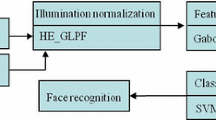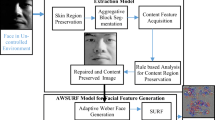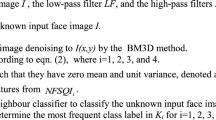Abstract
Face recognition with variable illumination and pose is an important and challenging task in computer vision. In order to solve the problem that the accuracy of face recognition reduces with illumination and pose changes, this paper proposes a method via AMVP (AWULBP_MHOG_VGG_PCA) features and WSRC. In the proposed method, we need to extract AWULBP_MHOG and VGG_PCA features, respectively. As for AWULBP_MHOG features, firstly, variable illumination is normalized for face images. And uniform local binary pattern (ULBP) and multiple histogram of oriented gradient (MHOG) features are extracted from each block, which are called ULBP_MHOG features. Then, we use information entropy to obtain adaptively weighted ULBP_MHOG (AWULBP_MHOG) features. As for VGG_PCA features, we use the pre-trained VGG-Face model to extract VGG features from original face images. And PCA is used to reduce the dimension of VGG features to obtain VGG_PCA features. Then, AWULBP_MHOG and VGG_PCA features are combined to form AMVP (AWULBP_MHOG_VGG_PCA) features. Finally, test face images can be classified using weighted sparse represent (WSRC). The comparison experiments with different blocks, classifiers and features have been conducted on the ORL, Yale, Yale B and CMU-PIE databases. Experimental results prove that our method can improve the accuracy effectively for illumination and pose variable face recognition.












Similar content being viewed by others
References
Garcia C, Delakis M (2004) Convolutional face finder: a neural architecture for fast and robust face detection. IEEE Trans Pattern Anal Mach Intell 26(11):1408–1423
Chellappa R, Wilson CL, Sirohey S (1995) Human and machine recognition of faces: a survey. Proc IEEE 83(5):705–741
Zhao W, Chellappa R, Phillips PJ et al (2003) Face recognition: a literature survey. ACM Comput Surv (CSUR) 35(4):399–458
Cao X, Shen W, Yu LG et al (2012) Illumination invariant extraction for face recognition using neighboring wavelet coefficients. Pattern Recogn 45(4):1299–1305
Yun SH, Kim JH, Kim S (2010) Image enhancement using a fusion framework of histogram equalization and laplacian pyramid. IEEE Trans Consum Electron 56(4):2763–2771
Tan X, Triggs B (2010) Enhanced local texture feature sets for face recognition under difficult lighting conditions. IEEE Trans Image Process 19(6):1635–1650
Basri R, Jacobs DW (2003) Lambertian reflectance and linear subspaces. IEEE Trans Pattern Anal Mach Intell 25(2):218–233
Gudur N, Asari V (2006) Gabor wavelet based modular PCA approach for expression and illumination invariant face recognition. In: 35th IEEE applied imagery and pattern recognition workshop (AIPR’06). IEEE, pp 13–18
Roy H, Bhattacharjee D (2016) Local-gravity-face (LG-face) for illumination-invariant and heterogeneous face recognition. IEEE Trans Inf Forensics Secur 11(7):1414–1424
Ramaiah NP, Ijjin EP, Mohan CK (2015) Illumination invariant face recognition using convolutional neural networks. In: 2015 IEEE international conference on signal processing, informatics, communication and energy systems (SPICES). IEEE, pp 1–4
Beymer DJ (1994) Face recognition under varying pose. In: IEEE computer society conference on computer vision and pattern recognition (CVPR). IEEE, pp 756–761
Kim TK, Kittler J (2005) Locally linear discriminant analysis for multimodally distributed classes for face recognition with a single model image. IEEE Trans Pattern Anal Mach Intell 27(3):318–327
Gross R, Matthews I, Baker S (2004) Appearance-based face recognition and light-fields. IEEE Trans Pattern Anal Mach Intell 26(4):449–465
Gonzalez-Jimenez D, Alba-Castro JL (2007) Toward pose-invariant 2-D face recognition through point distribution models and facial symmetry. IEEE Trans Inf Forensics Secur 2(3):413–429
Blanz V, Romdhani S, Vetter T (2002) Face identification across different poses and illuminations with a 3d morphable model. In: Fifth IEEE international conference on automatic face and gesture recognition. IEEE, pp 192–197
Chai X, Shan S, Chen X et al (2007) Locally linear regression for pose-invariant face recognition. IEEE Trans Image Process 16(7):1716–1725
Castillo CD, Jacobs DW (2011) Wide-baseline stereo for face recognition with large pose variation. In: IEEE conference on computer vision and pattern recognition (CVPR). IEEE, pp 537–544
Li A, Shan S, Gao W (2012) Coupled bias-variance tradeoff for cross-pose face recognition. IEEE Trans Image Process 21(1):305–315
Chen D, Cao X, Wen F, et al (2013) Blessing of dimensionality: high-dimensional feature and its efficient compression for face verification. In: IEEE conference on computer vision and pattern recognition (CVPR). IEEE, pp 3025–3032
Li S, Liu X, Chai X, et al (2012) Morphable displacement field based image matching for face recognition across pose. In: European conference on computer vision. Springer, Berlin Heidelberg, pp 102–115
Asthana A, Marks TK, Jones MJ et al. (2011) Fully automatic pose-invariant face recognition via 3D pose normalization. In: International conference on computer vision. IEEE, pp 937–944
Jiang D, Hu Y, Yan S et al (2005) Efficient 3D reconstruction for face recognition. Pattern Recogn 38(6):787–798
Ghorbel A, Tajouri I, Aydi W, et al. (2016) A comparative study of GOM, uLBP, VLC and fractional Eigenfaces for face recognition. In: 2016 International conference on image processing, applications and systems (IPAS). IEEE, pp 1–5
Shu C, Ding X, Fang C (2011) Histogram of the oriented gradient for face recognition. Tsinghua Sci Technol 16(2):216–224
Tan H, Yang B, Ma Z (2014) Face recognition based on the fusion of global and local HOG features of face images. IET Comput Vis 8(3):224–234
Bhele SG, Mankar VH (2015) Recognition of faces using discriminative features of LBP and HOG descriptor in varying environment. In: 2015 International conference on computational intelligence and communication networks (CICN). IEEE, pp 426–432
Parkhi OM, Vedaldi A, Zisserman A (2015) Deep face recognition. In: British machine vision conference, pp 1–12
Shi S, Yang C, Wang T et al (2013) Face image enhancement based on self-quotient Image. Comput Eng Appl 49(13):142–144
Moghaddam B, Pentland AP (1994) Face recognition using view-based and modular eigenspaces. In: SPIE’s 1994 international symposium on optics, imaging, and instrumentation. international society for optics and photonics, pp 12–21
Cosma C, Brehar R, Nedevschi S (2013) Pedestrians detection using a cascade of LBP and HOG classifiers. In: IEEE international conference on intelligent computer communication and processing (ICCP). IEEE, pp 69–75
Ojala T, Pietikainen M, Maenpaa T (2002) Multiresolution gray-scale and rotation invariant texture classification with local binary patterns. IEEE Trans Pattern Anal Mach Intell 24(7):971–987
Dalal N, Triggs B (2005) Histograms of oriented gradients for human detection. In: IEEE computer society conference on computer vision and pattern recognition (CVPR). IEEE, pp 886–893
Shi W (2016) Facial expression recognition based on adaptive weighted LBP and collaborative representation. Nanjing: Nanjing University of Posts and Telecommunications, M. S. Thesis
Fan Z, Ni M, Zhu Q et al (2015) Weighted sparse representation for face recognition. Neurocomputing 151(1):304–309
Yu K, Zhang T (2010) Improved local coordinate coding using local tangents. In: Proceedings of the 27th international conference on machine learning (ICML-10), pp 1215–1222
Lu CY, Min H, Gui J et al (2013) Face recognition via weighted sparse representation. J Vis Commun Image Represent 24(2):111–116
AT&T Laboratories Cambridge, “The Database of Faces” [DB/OL]. Available: http://www.cl.cam.ac.uk/research/dtg/attarchive/facedatabase.html
UCSD Computer Vision, “Yale Face Database” [DB/OL]. Available: http://vision.ucsd.edu/content/yale-face-database
Belhumeur PN, Hespanha JP, Kriegman DJ (1997) Eigenfaces vs. fisherfaces: recognition using class specific linear projection. IEEE Trans Pattern Anal Mach Intell 19(7):711–720
Baker S, Sim T, Bsat M (2003) The CMU pose, illumination, and expression database. IEEE Trans Pattern Anal Mach Intell 25(12):1615–1618
Acknowledgements
This work has been supported by National Natural Science Foundation of China (61203261), China Postdoctoral Science Foundation funded project (2012M521335), Jiangsu Key Laboratory of Big Data Analysis Technology/B-DAT (Nanjing University of Information Science & Technology, Grant No.: KXK1404), Research Fund of Guangxi Key Laboratory of Multi-source Information Mining & Security (MIMS16-02) and the Fundamental Research Funds of Shandong University (2015JC014 and 2017JC043). We would also like to thank the ORL database of faces captured by AT & T Cambridge Laboratory, the Yale face database and the Yale face database B provided by the Center for Computational Vision and Control at Yale University and the CMU-PIE database from Carnegie Mellon University, respectively.
Author information
Authors and Affiliations
Corresponding author
Ethics declarations
Conflict of interest
We declare that we have no conflict of interest.
Rights and permissions
About this article
Cite this article
Wang, K., Chen, Z., Wu, Q.M.J. et al. Face recognition using AMVP and WSRC under variable illumination and pose. Neural Comput & Applic 31, 3805–3818 (2019). https://doi.org/10.1007/s00521-017-3316-x
Received:
Accepted:
Published:
Issue Date:
DOI: https://doi.org/10.1007/s00521-017-3316-x




